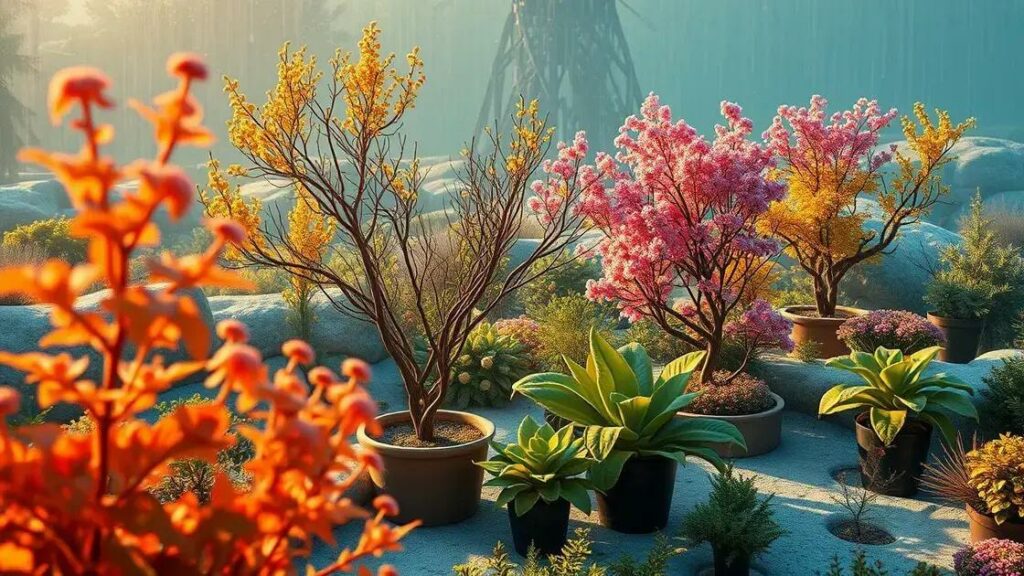How to take care of plants in winter can seem daunting, with chilly temperatures and shorter days posing unique challenges. However, with the right strategies, you can ensure your plants not only survive but thrive in winter. Delve deeper into this seasonal care guide to discover how to create the ideal environment for your greenery.
Table of Contents
ToggleUnderstanding the unique challenges of winter plant care
Understanding the unique challenges of winter plant care is essential for all plant lovers. The winter season introduces various hurdles that can impact the health and vitality of your plants. During these colder months, houseplants may struggle with insufficient light, low humidity, and cooler temperatures. Here’s a closer look at these challenges and how you can effectively address them.
Low light conditions
As daylight hours shorten, your plants might not receive the necessary light for photosynthesis. To combat this:
- Move plants closer to windows or utilize grow lights to supplement natural light.
- Rotate pots regularly to ensure all sides of the plant receive equal light exposure.
Low humidity levels
Winter heating can significantly reduce indoor humidity, causing stress for many houseplants. You can help maintain adequate moisture levels by:
- Using a humidifier in the room where your plants are located.
- Grouping plants together to create a microenvironment.
- Placing a tray of water with pebbles near the plants to increase humidity.
Temperature fluctuations
Sudden drops in temperature can harm plants. Keep your indoor plants in stable environments by:
- Avoiding placement near cold drafts from windows and doors.
- Maintaining a consistent indoor temperature, ideally between 65°F and 75°F.
Common mistakes to avoid
When caring for plants in winter, some common pitfalls include overwatering due to reduced growth and insufficient light. Make sure to:
- Check the moisture levels before watering.
- Avoid fertilizing unless plants are actively growing.
By understanding these unique challenges of winter plant care, you’ll be better equipped to tackle the seasonal hurdles your plants face. For additional tips on houseplant care during the colder months, consider exploring indoor gardening techniques.
With a little extra attention, your plants can survive and even thrive throughout the winter months!
Best indoor gardening tips for thriving during winter

Best indoor gardening tips for thriving during winter will help you maintain healthy greenery amidst the seasonal challenges. Indoor plants can showcase their full potential even during winter with the right strategies and care. Here are some effective tips to ensure your plants thrive throughout the chilly months.
Utilize proper lighting techniques
During winter, natural light can be limited. To enhance the light exposure, consider the following:
- Position plants near south-facing windows for maximum sunlight.
- Use full-spectrum grow lights to supplement natural sunlight.
- Rotate pots every few weeks to expose all sides of the plants to light.
Maintain optimal humidity levels
A dry indoor environment can stress your plants. Keep humidity levels optimal with these tips:
- Place a humidifier in the room to increase moisture content.
- Set up pebble trays filled with water beneath your pots.
- Group your plants together to create a micro-climate.
Adjust watering practices
When caring for your indoor plants in winter, it’s essential to adjust your watering approach:
- Check soil moisture before watering. Plants typically require less water in winter.
- Avoid letting plants sit in excess water, as this can lead to root rot.
Choose the right plant types
When selecting plants for winter indoors, consider varieties better suited for low-light and higher humidity:
- ZZ plants and snake plants are great for beginners.
- Pothos and peace lilies appreciate humidity and low light.
- Consider annuals and winter-blooming plants to add color indoors.
These indoor gardening tips for thriving during winter will help keep your plants healthy and vibrant despite the cold weather. If you’re interested in more detailed strategies, don’t forget to check out exploring indoor gardening techniques.
Protecting outdoor plants from harsh winter conditions
Protecting outdoor plants from harsh winter conditions is crucial for their survival and health. As temperatures drop and the weather becomes unpredictable, your outdoor plants can suffer significant stress. Here are some effective strategies to shield your plants from the biting cold and ensure they thrive through winter.
Choose appropriate winter protection techniques
Different plants require different protective measures. Here are some effective methods:
- Apply mulch around the base of plants to insulate roots and maintain soil temperature.
- Use frost cloths or burlap to cover sensitive plants during frost warnings.
- Install plant protection bags for individual plants vulnerable to cold.
Watering practices during winter
Although watering might decrease in winter, it’s essential to maintain some moisture:
- Water plants during warmer days to ensure root hydration.
- Check soil moisture regularly, as winter winds can dry out the soil.
- Avoid overwatering, as this can lead to root rot in cooler temperatures.
Evaluate plant placement
Where you position your outdoor plants can impact their ability to withstand winter conditions:
- Move potted plants to sheltered areas such as patios or porches.
- Group plants together to create a microclimate that preserves warmth.
- Plant hardy varieties in southern or western exposures for optimal sun exposure.
Monitor for pests and diseases
Cold weather can still harbor pests and diseases:
- Regularly inspect plants for signs of pests, even in winter.
- Use organic pesticides if necessary to manage any infestations.
Implementing these strategies for protecting outdoor plants from harsh winter conditions will significantly increase their chances of thriving. And if you’re curious about expanding your gardening techniques, don’t forget to check out exploring indoor gardening techniques.
In conclusion
Caring for plants during winter requires understanding the unique challenges they face and implementing effective strategies to ensure their health. By following the best indoor gardening tips, protecting outdoor plants, and making necessary adjustments to your care routine, you can help your greenery thrive during the colder months. Additionally, if you’re looking for more ways to enhance your indoor garden, check out these tips on enhancing your indoor garden.

